| ALL STAR |
 |
 Bonalyn Boyd, director of marketing, east region, Ista North America, oversees the company's advertising, trade shows, web marketing, and internal communications. She has more than 20 years of experience in marketing, and has learned that creative, consistent messaging aids in generating leads and leaving a lasting impression on visitors. Bonalyn Boyd, director of marketing, east region, Ista North America, oversees the company's advertising, trade shows, web marketing, and internal communications. She has more than 20 years of experience in marketing, and has learned that creative, consistent messaging aids in generating leads and leaving a lasting impression on visitors. |
 |
 ccording to the late Malcolm Forbes, "There is never enough time, unless you're serving it." While most of us can attest to the validity of the publisher's statement, Bonalyn Boyd felt the full force of Forbes' words as she began planning for the 2010 National Apartment
Association (NAA) Education Conference & Exposition. ccording to the late Malcolm Forbes, "There is never enough time, unless you're serving it." While most of us can attest to the validity of the publisher's statement, Bonalyn Boyd felt the full force of Forbes' words as she began planning for the 2010 National Apartment
Association (NAA) Education Conference & Exposition.
Boyd, the east region's director of marketing for energy-management and utility-billing provider Ista North America, always had sizeable hurdles to clear for the NAA show. Not only were exhibitors continually engaged in an all-out war for attendees' time and attention, but Ista's budget was practically puny compared to the show's behemoth exhibitors. But at NAA 2010, held June 24 - 25 in New Orleans, time wasn't just scarce for Boyd and her team; it was working against her.
Given the sluggish economy - and the fact that neither the show nor exhibitors had an extra dime to spare - show management decreased the exhibit-hall schedule from three days to two (and thus cut costs for venue rental, electrical, booth cleaning, etc.). In the blink of an eye, the time Ista had to attract attendees, educate them about its services, and nurture relationships was slashed by one-third. Thus, Boyd and her marketing team had to somehow eke out every spare minute they could with attendees, and make sure that every second attendees spent with the company was as effective as possible.
To that end, Boyd created an integrated program that magically gave Ista plenty of time with attendees. She and her team also conjured on-brand, on-target booth activities that kept attendees in Ista's exhibit - and out of the competition's - for more than 30 minutes. Hailed by judges as "ingenious and well integrated," Ista's NAA marketing strategy generated 42 percent more leads compared to its 2009 results - all despite one less day of exhibiting.
Time-Consuming Troubles
Boyd's award-winning strategy, however, didn't just tackle the time crunch NAA put into play. Ista had other challenges that made Boyd's solutions even more impressive. Right off the top, explaining Ista's services usually can't be condensed into a 10-second elevator speech, which
means salespeople need time for explanation before they can even think about selling anything.
Ista offers various utility-billing and energy-related services, and Boyd works for the east region of Ista's multi-family division, based in Jacksonville, FL. "My part of the company serves shopping malls, apartment buildings, manufactured homes, etc.," Boyd says.
"Many facilities like this have a master-metering system, whereby an entire apartment building, for example, is on a single electrical and water meter. With this system, there's no way for the complex to know how much each individual unit is using and to charge renters accordingly. As such, renters use as much of the utilities as they want, and the complex has to foot the bill. Granted, the complex usually guesstimates yearly utility charges, averages them out, and includes them in monthly rental fees. But this often means the complex comes up short by year's end, and winds up paying more for utilities than it actually collects from residents."
So Ista puts utility submeters on individual units, and tracks exactly how much each unit is using. "We then read the meters, generate bills for individual units, and collect their payments," Boyd says. "Later, we write a check to the building management for the total amount we've collected that month. Individual units must pay for what they use, which means that the complex recoups all utility expenses, thereby saving money in the long run."
Obviously, then, extolling the virtues of Ista's services isn't as easy as saying "We sell blue widgets." What's more, implementing this system requires a considerable amount of time and installation for facilities - as well as a long-term commitment. So it takes time both on and off the show floor to educate and sell prospects on the service.
Not surprisingly, Ista's marketing department focuses on the quantity, versus quality, of leads, and on generating visibility at shows. "Our salespeople want every single lead we can send their way," Boyd says. "They're prepared to nurture these leads over time - mostly because someone who might not be a good lead today could be a hot lead tomorrow. Plus, they want everyone at the show to be aware of us. That way, when salespeople call a prospect after the show, the prospect has at least heard of the company."
As if that laundry list of objectives wasn't enough, Boyd and her team had several more hurdles to clear at this particular show. "NAA is the big daddy of shows in our industry where exhibitors pull out all the creative stops," Boyd says. "Plus, this show draws some huge companies with big budgets. So even though we don't necessarily compete with them in terms of services, we all battle for attendees' time. So while we're trying to woo attendees to our 20-by-50-foot space, Lowes, for example, might be holding a drawing for a $200 gift card every hour in its booth just 10 feet away."
This competition for attendee mindshare rages after show-floor hours as well. Many companies hold big, expensive parties at night, and the show hosts its own event one evening. Plus, the 2010 show city, New Orleans, is hard for any exhibitor to compete with, given its endless entertainment options. Additionally, in 2010, management cut the NAA budget by 10 percent, essentially ruling out any chance of going head-to-head with the big guns in a no-holds-barred hospitality shootout.
Take all these problems and toss in the fact that show-floor hours had been cut by one-third, and Ista's issues went from code-orange serious to red-zone (Ah-oo-ga! Ah-oo-ga!) alarming. "So as I sat down to plan NAA with my teammates - Amanda Holden, the west region's marketing director, and Michelle Potter, the central region's marketing director - we knew that time was the golden egg," Boyd says. "While we had to accomplish our underlying goals, in 2010 we had to find a way to score time with people outside of exhibit-hall hours, and employ additional booth tactics to help retain people as long as possible."
A Sandwich, a Song, and a Vision
Ista's solution was born out of a lunchtime brainstorming session at EXHIBITOR2010, an educational conference and exposition for exhibit and event marketers. As Boyd, Holden, and Potter lunched, they talked about new ways to not only overcome the 2010 show's unique obstacles, but also to draw attention to new things happening at Ista.
"We had a new CEO, new energy-management programs, and a new corporate structure featuring regional offices throughout the U.S.," Boyd says. "So we wanted people to take another look at us. As we were sitting in the restaurant, the song 'I Only Have Eyes for You' began to play on the sound system. That got us thinking about eyes ... and looking ... and seeing. We figured that when someone says 'Look out!' or 'Look up!' everyone pays attention. So we came up with our show theme, 'Look at the new Ista!' and we planned to use images of people's heads from the nose up as a unifying visual."
Soon, the trio had devised an ingenious pre-show strategy and
several in-booth activities that they hoped would educate attendees about Ista services and give salespeople critical face time with attendees.
The IstaCAR Takes Off
The first idea that Boyd and her team implemented was also the first activity attendees encountered at the show: the IstaCAR (Client-Appreciation Ride). "A few months before the show, my team and I went to New Orleans to scout hotels for our staff," Boyd says. "As we rode from the airport to a hotel, it suddenly hit us: The 35 to 50 minutes between when people leave the airport and when they actually arrive at their hotels was our golden opportunity to score time with NAA attendees. This transportation time provided an atmosphere free of competitors, not to mention the bells and whistles of the trade show floor. Plus Ista would be attendees' first show-related contact and would hopefully make a positive, lasting impression."
Prior to the show, salespeople created a list of their best clients attending NAA. Boyd and the team then sent them an e-mail, which explained that Ista would provide free transportation from the airport to their individual show hotels. The e-mail also directed them to a website where
they could input their flight info, hotel destination, and number of people traveling with them.
Next, Ista mailed registered participants a small package that included details about where to go and what to expect along with a branded luggage tag. The 5-inch diameter tag in Ista's bright-orange corporate hue featured the Ista logo and product messages on the front and room for attendees to input their contact information on the back. The couldn't-miss tag would assist Ista staff in spotting participants' luggage on the airport carousels and create added brand awareness throughout the airport and at show hotels.
At the airport the day before the show, registered IstaCAR participants found 22 Ista staff members waiting to assist them. Dressed in T-shirts emblazoned with an "IstaCAR" logo, the staffers each had a specific task. For example, one "greeter" and one "runner" were stationed at each concourse's baggage-claim entrance. Holding an IstaCAR-branded sign featuring the phrase "Savings REVEALED. Come SEE the new Ista!" each greeter welcomed attendees and handed each person a ticket - including his or her name, flight info, and hotel destination. The "runner" then escorted the attendee and any accompanying guests to the baggage area to collect their luggage. Next, it was off to the Ista-branded vehicles (again featuring the "Come SEE the new Ista!" messages) where attendees gave the driver their tickets, informing him or her where they needed to go.
"We had two mini-buses, which sat 24 people each, and one 10-person van," Boyd says. "We had one vehicle leaving every 30 minutes to shuttle attendees to their hotels, and each vehicle was branded with IstaCAR and 'Come SEE the new Ista!' signage. Thus, even if show attendees didn't take the shuttle, many of them saw our name at their hotels on the first day, as our shuttles dropped off participants."
But before attendees even left the airport, Ista staff aboard the vehicles set the mood for a NOLA-style experience. While zydeco music twanged through the vehicle speakers, staffers handed out Mardi Gras beads, cold washcloths (a must for NOLA in June), Zapp's potato chips (a New Orleans staple), and the attendee's choice of soda, water, or margaritas. During the 35- to 50-minute ride, staffers chatted with attendees about Ista's services. "This activity gave us priceless time with attendees as it allowed us to talk with them, uninterrupted, for up to 50 minutes," Boyd says.
Prior to the event, 122 attendees pre-registered for the transportation. However, with the addition of walkups at the airport, Ista transported 165 people in 10 hours. And while the service cost Ista roughly $4,000, Boyd felt the time spent with attendees was worth every dime.
Luggage-Tag Tactic
While the IstaCAR was a veritable stroke of genius, Ista's booth was also filled with several time-bending activities, all of which were somehow linked to the "Look at the new Ista!" theme. Boyd and her team figured that if they could just get people to the booth, scan their badges, and get them involved with anything from a game to a giveaway, staffers would weave themselves into the activities and generate the face-to-face time they needed. "So we created activities that we estimated would keep people in the booth for about 30 minutes," Boyd says. "If we couldn't sell them on our services during that time, then we just weren't doing our jobs."
Visitors to the 20-by-50-foot island exhibit, which was fabricated by ExhibitPro of Columbus, OH, discovered an open space with a central reception desk/hospitality station, along with various activity stations and signage supporting the theme. One sign, for example, featured an image of a man's face from the nose up and included the text "LOOK! Ista is so much more than a submetering company!"
Lured in by the signage and staffers - who explained that there were various activities and opportunities to win prizes - visitors soon made their way to one of the activity stations, all of which were designed to capture attendees' contact information before starting the activity. One such station, for instance, offered attendees the same vibrant luggage tags used in the IstaCAR activity and a chance to win a Starbucks gift card in exchange for a swipe of their badge.
Staffers and booth signage explained that if attendees attached an orange tag to their show bags or whatever satchel-like items they were carrying, they had the chance to win a prize. Of course, as staffers attached the tags, they discussed Ista's offerings and asked about attendees' utility-related needs. They also explained that at some point every hour throughout the show, Ista staffers would comb the aisles in search of these luggage tags and give those bearing a tag a $10 Starbucks gift card.
"We estimated that this activity alone kept people with us for two to five minutes," Boyd says. "We handed out 500 tags at the show. At a cost of only about $1 each, the tags maximized our brand exposure across the show floor."
Money Down the Drain
Another station focused on Ista's money-saving benefits. Ista claims most multi-unit venues are throwing utility money down the drain without the company's services. Playing off this concept, Boyd implemented a
money-toss game using real toilets as the tongue-in-cheek receptacles. Ista positioned two toilets on one corner of its booth, along with logo-adorned signage proclaiming, "SEE THE MONEY you throw down the drain without
submetering. AND WIN MONEY!"
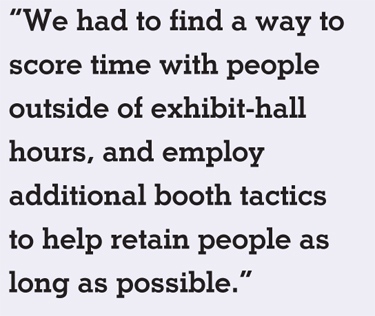 "We placed crumpled-up, faux money in various denominations into small buckets," Boyd says. "After filling out a lead card and getting their badges swiped, players stood on a orange carpet about 4 feet from the toilets. Each player had 15 seconds to toss as much money into his or her toilet as possible. When the time was up, staffers tallied the monetary scores and wrote each person's total on his or her lead card." "We placed crumpled-up, faux money in various denominations into small buckets," Boyd says. "After filling out a lead card and getting their badges swiped, players stood on a orange carpet about 4 feet from the toilets. Each player had 15 seconds to toss as much money into his or her toilet as possible. When the time was up, staffers tallied the monetary scores and wrote each person's total on his or her lead card."
All participants received a pair of sunglasses in a cloth carrying case (in keeping with Ista's "look, see" theme). But the person with the top score was eligible for an additional prize. Staffers placed this person's lead card onto an in-booth leader board and explained that he or she could win an additional prize. At the top of each hour, staffers reviewed the leader board and awarded the person with the highest score a $25 Visa gift card and a branded book filled with energy-management tips. Those who did not win the prize were placed into another drawing for a $10 gift card, also given away each hour, prompting attendees to return again to see if they'd won.
"As visitors waited their turn, we gathered lead information and engaged them in conversations about our company and services," Boyd says. "A total of 367 people played our game, and we estimated that this activity kept people in the exhibit for four to 15 minutes."
A Picture is Worth ... at Least Five Minutes
Also playing off the company's "Look" and "See" campaign, Boyd implemented a photo booth into the exhibit to give attendees a fun, branded giveaway to take home. "A photo booth isn't a new idea," Boyd says. "But people usually travel the show floor in small groups, so we wanted a fun group activity and something relatively inexpensive to give away."
To give staffers even more time to interact with attendees, Boyd added some props to the photo-booth activity. "Instead of just taking attendees' photos and letting them walk away, we figured we'd give them a chance to dress up and make more of an experience out of it," Boyd says. So her team stocked the booth with lots of props - various glasses (to suggest the "Look" theme), feather boas, odd hats, etc. Staffers helped attendees pick out their props, and after the photo, staffers stepped in to talk about Ista's services while attendees waited for their four-photo strip to print.
Of course, in order to participate in the activity,
interested attendees had to have their badges swiped, generating additional leads. "We spent less than $1,300 on the photo booth and gave out more than 600 Ista-branded photo strips," Boyd says. "Plus, we were able to direct people to see and share their photos online via the vendor's website, allowing us to extend the experience beyond the show hours." On average, this activity retained attendees for five to 20 minutes each, and provided them with a relatively inexpensive giveaway they no doubt kept (at least for a while) after the show.
Kegs and Connectors
Boyd's final two time-bending techniques involved a few brews and a charging station. "We wanted to give people a way to not only relax and enjoy their time with us, but also to take care of some important business - charging their cell phones," Boyd says.
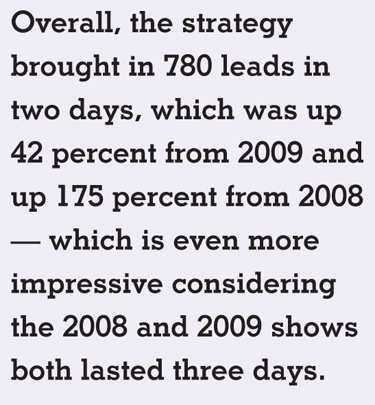 Positioned near Ista's energy-management display, the charging station offered a charging pod with eight of the
most popular types of phone adaptors. Signage urged people to "Charge your phone while you wait," but salespeople verbally offered this complimentary service to attendees as a way to extend their conversations. Boyd estimates that once attendees plugged in their cell phones, staffers had another three to 10 minutes to explain Ista's services. Positioned near Ista's energy-management display, the charging station offered a charging pod with eight of the
most popular types of phone adaptors. Signage urged people to "Charge your phone while you wait," but salespeople verbally offered this complimentary service to attendees as a way to extend their conversations. Boyd estimates that once attendees plugged in their cell phones, staffers had another three to 10 minutes to explain Ista's services.
While attendees ambled from one activity to the next, staffers offered them another reason to park it in the exhibit for a while: a pint-sized
cup of cold, imported beer. Since Ista's parent company is based in Germany, it typically served imported German beer in the booth during shows. But for the 2010 exhibit, Boyd increased the size of the branded cups to about a pint, which meant that rather than swigging down the brew and leaving the booth, most people stood around and finished their pint - giving staffers an opportunity to talk shop. Ista calculated that the biggie-sized beer added one to two more minutes onto attendees' time in the booth.
Up-to-the-Minute Results
Like some magical marketing maven, Boyd seemingly bent time and secured more minutes with attendees - and more leads - than ever before. On average, attendees spent 33.5 minutes in Ista's booth, in addition to the 35 to 50 minutes IstaCAR participants spent with staffers en route to their hotels. In contrast, Boyd estimates that attendees at NAA in 2009 only spent an average of 12 minutes in Ista's booth.
Along these same lines, Ista's 2010 lead counts crushed the company's previous results. Overall, the strategy brought in 780 leads in two days, which was up 42 percent from 2009 and up 175 percent from 2008 - which is even more impressive considering the 2008 and 2009 shows both lasted three days.
Boyd's meticulous measurement also revealed that Ista distributed 500 luggage tags, 625 pints of beer, 216 bottles of water, and 628 photo strips - each one of which offered added awareness and visibility for the brand. Plus, she estimates that 367 attendees participated in the money toss, roughly half of which returned to the booth at least once to see if their high scores held out.
According to All-Star Awards judges, all of these results have nothing to do with money and everything to do with creativity. "This is a great example of what a smallish
company can do when it really thinks big," judges said.
Indeed, fun went a long way for Ista. "This was the most effective trade show program in our company history," Boyd says. "We dominated the competition by the sheer volume of leads we generated and the number of bodies camped out in our booth. Plus we've already contracted or closed deals that more than cover the cost of the show as
a direct result of the leads we gathered."
So hat's off to this time bender. While she had the same amount of time as other NAA exhibitors, she used smart strategies and innovative ideas to extract every ounce of effectiveness from every second
- proving that time, like life, is
what you make of it. E
|





 ccording to the late Malcolm Forbes, "There is never enough time, unless you're serving it." While most of us can attest to the validity of the publisher's statement, Bonalyn Boyd felt the full force of Forbes' words as she began planning for the 2010 National Apartment
Association (NAA) Education Conference & Exposition.
ccording to the late Malcolm Forbes, "There is never enough time, unless you're serving it." While most of us can attest to the validity of the publisher's statement, Bonalyn Boyd felt the full force of Forbes' words as she began planning for the 2010 National Apartment
Association (NAA) Education Conference & Exposition. 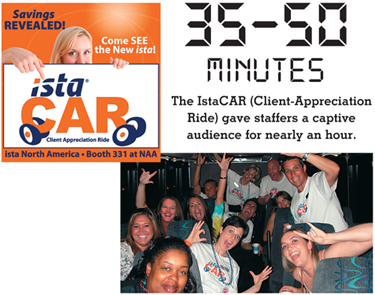


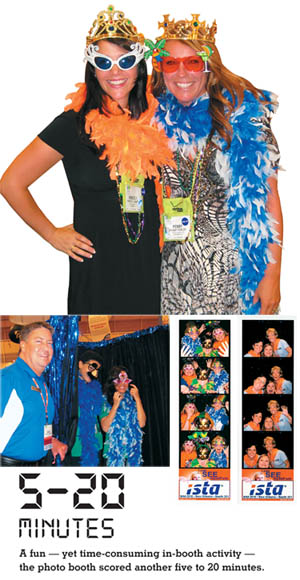
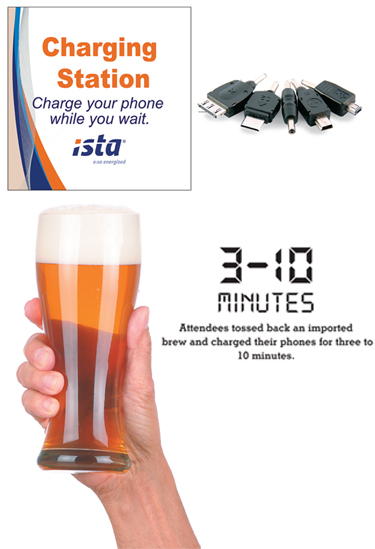
 "We placed crumpled-up, faux money in various denominations into small buckets," Boyd says. "After filling out a lead card and getting their badges swiped, players stood on a orange carpet about 4 feet from the toilets. Each player had 15 seconds to toss as much money into his or her toilet as possible. When the time was up, staffers tallied the monetary scores and wrote each person's total on his or her lead card."
"We placed crumpled-up, faux money in various denominations into small buckets," Boyd says. "After filling out a lead card and getting their badges swiped, players stood on a orange carpet about 4 feet from the toilets. Each player had 15 seconds to toss as much money into his or her toilet as possible. When the time was up, staffers tallied the monetary scores and wrote each person's total on his or her lead card."  Positioned near Ista's energy-management display, the charging station offered a charging pod with eight of the
most popular types of phone adaptors. Signage urged people to "Charge your phone while you wait," but salespeople verbally offered this complimentary service to attendees as a way to extend their conversations. Boyd estimates that once attendees plugged in their cell phones, staffers had another three to 10 minutes to explain Ista's services.
Positioned near Ista's energy-management display, the charging station offered a charging pod with eight of the
most popular types of phone adaptors. Signage urged people to "Charge your phone while you wait," but salespeople verbally offered this complimentary service to attendees as a way to extend their conversations. Boyd estimates that once attendees plugged in their cell phones, staffers had another three to 10 minutes to explain Ista's services. 






